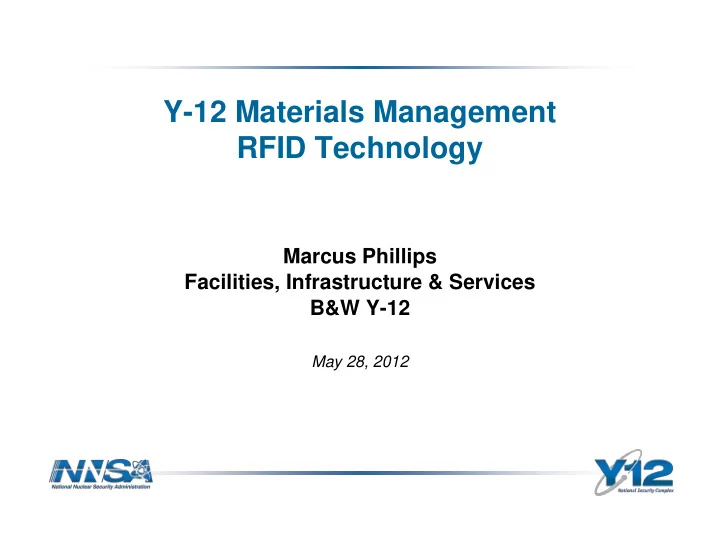

Y-12 Materials Management RFID Technology Marcus Phillips Facilities, Infrastructure & Services B&W Y-12 May 28, 2012
Former Receiving Process • Labels were printed off at the vendor’s location and placed on all packages by the Vendor. • The labels contain printed information as well as a liner barcode. – The printed information is the PO #, the end users requested drop point (i.e. building or office number), Recipients name/phone number and accountable property or inspection required indicators. • Material arrived at Receiving with barcode labels affixed to each package.
Former Receiving Process • A Material Clerk used a hand held scanner to scan each barcode – Communicated PO# wirelessly back to a desk top PC • Once all bar codes were scanned, the Material Clerk checked the number of PO’s scanned against the number of PO’s the vendor says they were dropping off, (minus price changes, quantity changes etc.). • If the numbers matched, they submitted the data and all the scanned PO’s were processed.
RFID Process • Materials for a selected vendor now arrives with an RFID barcode label attached. • Labels appear the same. However, the RFID barcode label also has this same information encrypted into a small radio antenna contained within the bar code label. – RFID barcode label is referred to as a passive label. In other words, it will not transmit any information until a scanner/reader/portal activates the antenna.
RFID Process • The Material Clerk now simply pulls the trigger on the scanner, walks around a skid of material, and all the PO #’s from the affixed RFID labels are transmitted to the scanner. • The scanner captures all PO #’s and provides the clerk with a total.
RFID Process • The Material Clerk validates the total PO #’s scanned vs. the PO’s #’s the vendor says they delivered. • If the number matches, then the scanner is placed in a docking station – Data is transferred to the desk top CPU where receipts are processed
Points of Interest • The printing and encoding of an RFID barcode requires a special printer costing ~3K • RFID scanners cost 3K • Current cost for an RFID barcode label is about .05 to .07 each. • We bought and provided this printer to the vendor for the pilot program. Due to cost savings and process improvements realized from RFID, we have discussed providing printers to all of our current AVID vendors – Would require any new AVID vendors to supply their own • The fact that the packages now have RFID barcode labels attached to them opens up several other windows of opportunity on the delivery side of the supply chain.
Pros • Time required to scan material is cut by 95%. • Material is moved from the receiving area to the distribution area much quicker. • The scanner can also be placed in a fixed location, (i.e. next to a roller table) where packages pass within a close proximity and the PO data is then scanned/read and stored • If the RFID scan should fail, the linear barcode is still printed on the label itself so linear scanning of the barcode is still an alternative.
Cons
Questions?
Recommend
More recommend